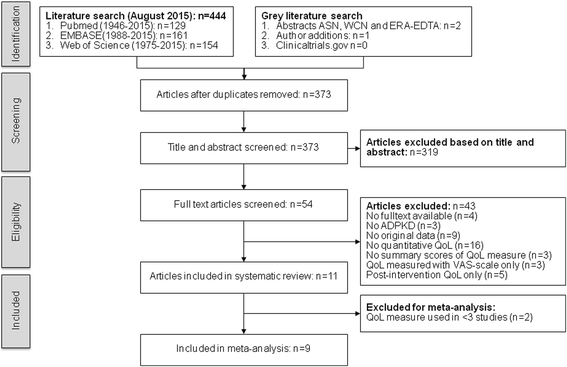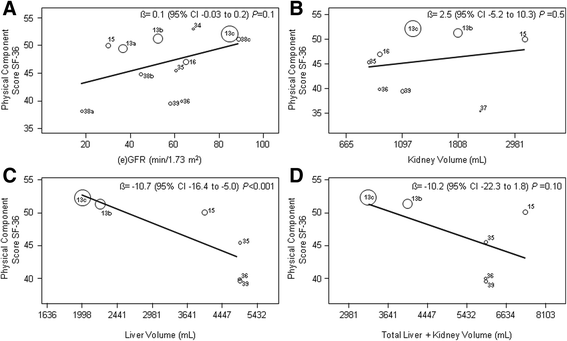The effect of disease severity markers on quality of life in autosomal dominant polycystic kidney disease: a systematic review, meta-analysis and meta-regression
- PMID: 28545401
- PMCID: PMC5445294
- DOI: 10.1186/s12882-017-0578-6
The effect of disease severity markers on quality of life in autosomal dominant polycystic kidney disease: a systematic review, meta-analysis and meta-regression
Abstract
Background: Little is known about determinants of quality of life (QoL) in autosomal dominant polycystic kidney disease (ADPKD). Recent studies suggest that QoL in ADPKD is determined by more factors than mere renal function. We investigated the effect of ADPKD on QoL and evaluated how Qol is affected by disease severity markers renal function, kidney volume and liver volume.
Methods: We performed a systematic review, meta-analysis and meta-regression analyses of cohort studies and randomized controlled trials investigating patient-reported QoL in adult patients with ADPKD not yet on dialysis. EMBASE, MEDLINE, and Web of Science were searched to August 2015 without language restrictions. Two investigators independently reviewed title, abstracts and full text of potentially relevant citations to determine eligibility. We compared pooled QoL summary scores of ADPKD patients using a random-effects meta-analytic model. These scores were compared with mean and age-corrected reference scores of the general population. In a meta-regression analysis, we investigated the univariate effect of renal function, kidney volume and liver volume on QoL.
Results: We included nine studies in meta-analysis including 1623 patients who completed the SF-36 questionnaire. Pooled physical (PCS) and mental component scores (MCS) of the SF-36 of individuals with ADPKD were lower than those of the reference population (45.7 vs. 50.0 and 47.8 vs. 50.0 points, both P < 0.001). QoL of ADPKD patients remained lower after comparison with age-corrected reference values (age 35-44 year; PCS 52.2, MCS 49.9 points, both P < 0.05). Larger liver volume negatively impacted PCS (P < 0.001) and MCS (P = 0.001), whereas there was no association with renal function (PCS P = 0.1, MCS P = 0.9) and kidney volume (PCS P = 0.5, MCS P = 0. 5). Total liver and kidney volume had no impact on PCS (P = 0.1), but did have impact on MCS (P = 0.02).
Conclusions: QoL reported by non-dialysis patients with ADPKD is impaired compared to the general population. Large liver volume was the most important factor that diminishes QoL. PROSPERO International Registry number CRD42015026428.
Keywords: Autosomal dominant polycystic kidney disease; Kidney volume; Liver volume; Quality of life; Renal function.
Figures




Similar articles
-
Signs and symptoms to determine if a patient presenting in primary care or hospital outpatient settings has COVID-19.Cochrane Database Syst Rev. 2022 May 20;5(5):CD013665. doi: 10.1002/14651858.CD013665.pub3. Cochrane Database Syst Rev. 2022. PMID: 35593186 Free PMC article.
-
Is Regular Screening for Intracranial Aneurysm Necessary in Patients with Autosomal Dominant Polycystic Kidney Disease? A Systematic Review and Meta-analysis.Cerebrovasc Dis. 2017;44(1-2):75-82. doi: 10.1159/000476073. Epub 2017 May 13. Cerebrovasc Dis. 2017. PMID: 28502970
-
Systemic pharmacological treatments for chronic plaque psoriasis: a network meta-analysis.Cochrane Database Syst Rev. 2021 Apr 19;4(4):CD011535. doi: 10.1002/14651858.CD011535.pub4. Cochrane Database Syst Rev. 2021. Update in: Cochrane Database Syst Rev. 2022 May 23;5:CD011535. doi: 10.1002/14651858.CD011535.pub5. PMID: 33871055 Free PMC article. Updated.
-
Drugs for preventing postoperative nausea and vomiting in adults after general anaesthesia: a network meta-analysis.Cochrane Database Syst Rev. 2020 Oct 19;10(10):CD012859. doi: 10.1002/14651858.CD012859.pub2. Cochrane Database Syst Rev. 2020. PMID: 33075160 Free PMC article.
-
Music interventions for improving psychological and physical outcomes in people with cancer.Cochrane Database Syst Rev. 2021 Oct 12;10(10):CD006911. doi: 10.1002/14651858.CD006911.pub4. Cochrane Database Syst Rev. 2021. PMID: 34637527 Free PMC article.
Cited by
-
Quality of Life in Autosomal Dominant Polycystic Kidney Disease Patients Treated With Tolvaptan.Kidney Med. 2020 Feb 26;2(2):162-171. doi: 10.1016/j.xkme.2019.11.008. eCollection 2020 Mar-Apr. Kidney Med. 2020. PMID: 32964204 Free PMC article.
-
Dietary Aspects and Drug-Related Side Effects in Autosomal Dominant Polycystic Kidney Disease Progression.Nutrients. 2022 Nov 3;14(21):4651. doi: 10.3390/nu14214651. Nutrients. 2022. PMID: 36364911 Free PMC article. Review.
-
Flank pain has a significant adverse impact on quality of life in ADPKD: the CYSTic-QoL study.Clin Kidney J. 2022 Jun 6;15(11):2063-2071. doi: 10.1093/ckj/sfac144. eCollection 2022 Nov. Clin Kidney J. 2022. PMID: 36825031 Free PMC article.
-
The relationship between liver cyst volume and QOL in Japanese ADPKD patients.Clin Exp Nephrol. 2020 Apr;24(4):314-322. doi: 10.1007/s10157-019-01830-6. Epub 2019 Dec 26. Clin Exp Nephrol. 2020. PMID: 31875934
-
Non-contrast low-dose CT can be used for volumetry of ADPKD.BMC Nephrol. 2023 Oct 26;24(1):317. doi: 10.1186/s12882-023-03359-z. BMC Nephrol. 2023. PMID: 37884882 Free PMC article.
References
Publication types
MeSH terms
Substances
Grants and funding
LinkOut - more resources
Full Text Sources
Other Literature Sources
Medical

